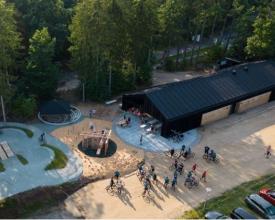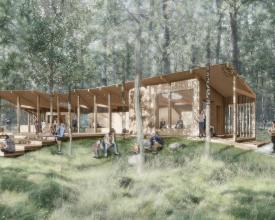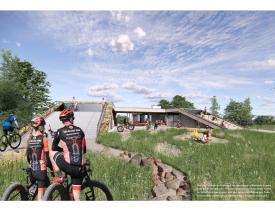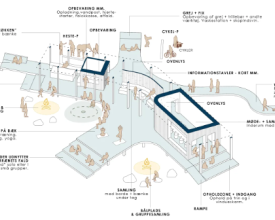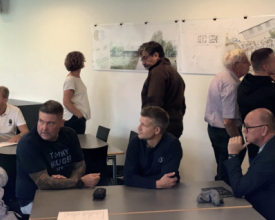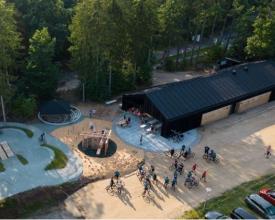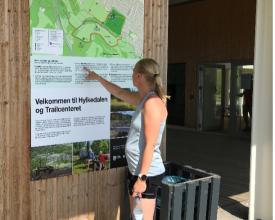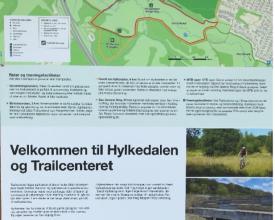
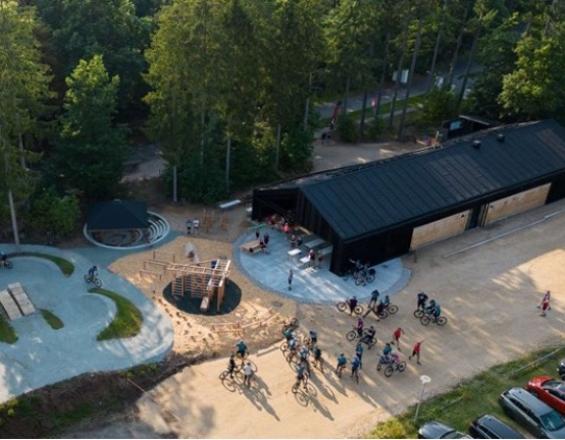
Responding to the increasing popularity of outdoor sports, the lack of sports facilities in Danish parks and nature, and the sometimes-conflicting interests when accessing nature, the National Olympic Committee and Sports Confederation of Denmark (DIF) and the Danish Foundation for Culture and Sports Facilities (LOA), have developed a ‘trail centres' pilot project. These centres for outdoor sports are located in, or near, nature, and provide individuals and sports associations with a space to meet, train, and access service facilities and information about outdoor activities.
The centres facilitate and encourage engagement with nature through outdoor sports, providing a physical space for informing people about the local natural environment and how to respect it. They aim to make people more aware of, and interested in, the nature that underpins their activities. The centres also aim to protect nature and avoid damage to habitats and species by drawing activities away from vulnerable natural areas.
Context
Challenges addressed
Trail Centres respond to the needs of both nature and people. There was a lack of sports facilities in Danish parks and nature, particular in the face of the number involved in outdoor sports and activities in nature. Given the need for more sports facilities and meeting places in parks and nature, the trail centre concept helps to bridge this gap by developing and building facilities that are specifically designed for outdoor sports in and around nature. Designing trail centres, rather than more traditional sports facilities, ensures these facilities are developed to match the needs of different user groups while promoting access and engagement with nature and outdoor sports.
Protecting nature and avoiding damage to habitats and species is an additional challenge addressed by trail centres. They help to draw activities aware from vulnerable natural areas whilst also providing physical sites for educational information about how to respect nature and behave accordingly.
Location
Process
Summary of the process
Using a participatory and cross-sectorial approach during the planning and design stages of trail centre development has enabled different parties to work together to delineate the minimum criteria that underpin the key decisions made regarding where trail centres are located, what service functions they would provide, and what information they would share. Relationship-building was also crucial to understanding user needs, themselves crucial for developing trail centres that increase and improve access to nature and outdoor sports activities. This approach has helped developers understand the outdoor activities that are popular or possible in the area, ensuring that they include service facilities that enable access to these nature-based activities.
Improving access to nature may make trail centres, for some, first points of contact with nature and may be important learning centres in this regard. Working with local partners helps determine key information about the local natural environment that needs to be shared through the centres, and the regulations that need to be put in place to help protect it. Delineating minimum criteria regarding the information that trail centres must share with users will also contribute to this.
Building Blocks
Establishing minimum criteria for the location, design, and functions of the trail centres, and the information that they must provide to users
To ensure the success of trail centres, the project members developed a number of minimum criteria for the location and design of the trail centres. Criteria was also established regarding the minimum service functions that the trail centres need to accommodate as well as the information that centres need to present.
Minimum criteria:
- located at the centre of a varied range of trails, routes, and tracks that are preferably marked
- situated in an interesting park area, terrain, landscape or natural area
- information about e.g. the routes’ terrain, length, degree of difficulty, changes in altitude
- parking spaces
- a common room that all sports associations can use
- a covered area for e.g. gatherings, warm-up stretches, abdominal exercises
- a good range of relevant service functions
Each of the centres that have been, or are being, developed adhere to these minimum criteria. They are all located in or near natural environments that provide access to different outdoor sporting activities. Core service functions are integral to the architectural designs of each centre.
Enabling factors
- Communication with local partners to understand user needs and determine core design functions.
- Clear vision: Project members established core purposes of trail centres
- Increasing social coexistence and understanding across different user-groups
- Developing all-in-one facilities that meet different user-group needs
- Increasing participation in, and accessibility of, nature-based sports/exercise
- Increasing awareness of, and interest in, the nature that underpins their activities
- Inspiring others to establish high-quality trail centres based on the above goals
Lesson learned
- Cross-sectorial collaboration is crucial for determining what criteria is deemed necessary for successful centres, as well as to better understand user needs.
- Establishing minimum criteria for trail centres ensures that these will accommodate and fulfil the service functions that are required and desired by users – critical for informing the architectural design of the centres.
- Determining minimum criteria also ensures that trail centres are situated in natural areas that provide opportunities for diverse outdoor activities. This guarantees that trail centres are located in the most suitable natural environments and in areas where many activities can be practiced. In some cases, it also provides opportunities to bridge the gap between urban and natural environments and facilitates access to nature for urban populations.
- Requiring trail centres to share information about their surrounding areas ensures that users have easy access to information relating to their outdoor activities as well as the best-practices and codes of conduct that one must adhere to whilst participating in outdoor nature-based activities.
Cross-sectorial cooperation and participatory approach to planning and design
The trail centre project was built on cross-sectorial cooperation. The five trail centres that are being built have all been developed and built in close collaboration with stakeholders across different sectors. These included the local municipalities where the centres would be built, the local sports associations who would be using the sites, local citizens and would-be users, as well as other interested parties.
The participatory approach included holding 4 to 5 workshops with stakeholders to understand user needs, ideas, etc. This both enabled and ensured dialogue between the architects involved in the planning and design processes of the trail centres and the users/interested parties. Dialogue with architects also ensured that the buildings’ aesthetics, as well as functions, met stakeholders’ wishes.
The activities provided, or facilitated, by the trail centres were developed in collaboration with the local actors and associations. A participatory approach to planning also gives the users and local community a greater sense of ownership and helps ensure a sense of community between actors and across their respective sports.
Additionally, the development of the minimum criteria for determining the location and functions of the trail centres arose through cross-sectorial collaboration between project members.
Enabling factors
- Holding numerous workshops with stakeholders across planning and design stages ensures consistent collaboration across sectors.
- Workshops with users facilitates greater understanding of user needs, opinions, and ideas which can positively influence the planning and design of trail centres. This can ultimately help determine the success of the trail centre in catering to user needs as well as the local community’s satisfaction with the end product.
Lesson learned
- Holding workshops with stakeholders helped architects and those delivering the project to understand user needs and helped inform the functions that trail centres should provide for their users. Workshops acted as a space where stakeholders could share ideas and voice their opinions, ultimately ensuring that centres could best meet local communities’ and users’ needs.
- Organising multiple workshops ensured that there was consistent dialogue and idea sharing between parties throughout the design and development stages of trail centres.
- A participatory approach to planning and design also enabled stakeholders to voice their opinions regarding the aesthetics of trail centres, an often-contentious topic that is crucial to the overall success of infrastructure projects.
Increasing and improving access to natural spaces and outdoor sporting activities
The Trail Centres act as physical spaces that increase and improve access to physical activities in nature, contributing to physical and mental well-being.
Their carefully chosen locations in proximity to nature (forests, water, and trails) help establish freely accessible, round-the-clock meeting places and start-points for outdoor sporting activities. As some are located close to urban areas, they also provide a gateway from urban to natural environments.
Their combination as an all-in-one clubhouse, provider of service facilities, and meeting and training space, makes them ideal sites for local sports associations to use, as well as un-affiliated groups or individuals. This provides a space for socialising within, and between, sports and promotes relationship-building amongst users and with local sports associations.
Providing access to service facilities participation in outdoor sports activities (e.g. bicycle pumps and cleaning stations; covered training space; functional training equipment (stairs, monkey bars, TRX, etc.); storage space for equipment; and changing rooms/showers/toilets). As sites for borrowing equipment (e.g. map and compass, roller skis, SUP boards, etc.), the centres also encourage people to try new activities in nature in an affordable manner.
Enabling factors
- The choice of location: trail centres must be near natural environments conducive to outdoor activities. Building them on the outskirts of urban areas, yet still close to nature, provides ideal gateways to nature. Analysis of recreational opportunities, infrastructure, terrain, etc. helps determine ideal locations.
- Correctly determining the functions and services to be provided by the trail centres to best-meet users’ needs.
Lesson learned
- Organising workshops with stakeholders allowed these to discuss and determine user needs as well as which functions trail centres needed to provide to accommodate these needs. This shaped the trail centres’ different designs and helped to determine the core facilities that centres had to provide, as well as the additional facilities specific to community needs or interests.
- Participatory workshops also ensured that trail centres provided access to activities and areas that could be appealing to users – both to those practicing outdoor activities as well as to those who might be interested in discovering new nature-based outdoor activities.
- Choosing to locate some centres near urban areas was also important for improving urban populations’ access to nature.
- Providing information about activities such as walking, running, and cycling trails (i.e. length, difficulty, the type of terrain, etc.) is helpful for encouraging people to undertake nature-based sporting activities, particularly those who may be less familiar with the local area or a specific activity.
Educating users about how to respect and behave responsibly in nature
As well as providing useful information about the surrounding natural area (e.g. trails, routes) and relevant information about this (e.g. routes’ terrain, length, degree of difficulty, changes in altitude), the trail centres also educate users on how to behave in nature. Codes of conduct educate users about how to respect nature while enjoying their sport/activity in a natural environment. For example, centres may provide information about how to respect nature when walking, running, or cycling on the local tracks, trails, and routes.
Some centres also provide information about the natural and cultural history on the routes, increasing users’ awareness of their natural environment.
Enabling factors
- Sharing information and best practice on how to behave responsibly and respectfully when in nature
- Clear information and explanations as to why it is important to behave responsibly and respectfully in nature
- Clear, effective, and easily accessibly communication channels through which information can be disseminated. The centres can act as hubs and physical spaces where information can be displayed (e.g. notice boards)
Lesson learned
- Establishing minimum criteria that required trail centres to provide users with information about the local area and activities that can be practiced there, encouraged trail centres to act as information hubs, informing users about the local natural environment, outdoor activities, and how to respect nature whilst enjoying outdoor sporting activities.
- Providing information about activities such as walking, running, and cycling trails (i.e. length, difficulty, the type of terrain) encourages people to undertake activities in designated areas and limits encroachment into fragile or stressed natural areas.
- Trail centres can signpost people less familiar with nature as to where to go, what to do, but also how to behave responsibly toward nature and why it is important to do so.
Impacts
One of the most significant positive impacts relating to trail centres is that they increase and improve access to outdoor sports and nature. Those located close to urban areas, such as the Anebjerg Skov centre, facilitate access to nature from urban areas.
Trail centres have been used as a start-point for outdoor sporting activities in the surrounding areas, with local sports associations basing themselves at the centres (able to store equipment, use meeting spaces, etc). The centres have, therefore, become popular meeting places for both organised and unorganised parties.
Indoor activities, such as yoga, fitness, and boxing, have also begun to use the trail centres for their activities, suggesting that building trail centres can enable more traditionally indoor sports to be practiced in and around nature.
The centres have also improved access to training and service facilities in nature as centres are home to various training facilities such as bouldering walls, functional training equipment, or MTB/pump tracks. Service facilities (toilets/showers, cleaning, etc.) in proximity to nature have become more accessible, making it easier or more appealing to partake in activities based in nature.
An overall evaluation of all five trail centres will be undertaken once all five have been built.
Beneficiaries
The beneficiaries include the local communities where the trail centres are located, local sports associations, anyone interested in outdoor sports and/or nature, tourists, and the natural environment.
Sustainable Development Goals
Story
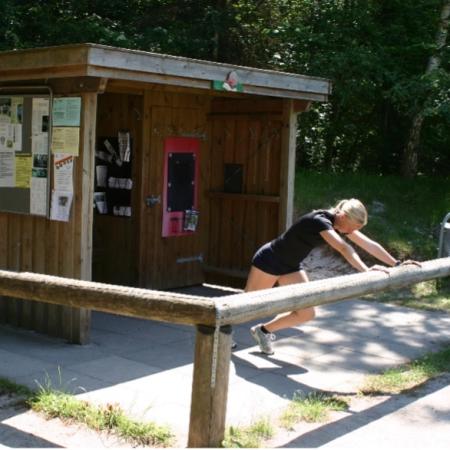
Some years ago, I experienced that in many places, mountain bikers meet at petrol stations. Here, they can get shelter, pump air into their bike tires, wash their bikes, and have the opportunity to buy water, Energy Gels, and so on.
Correspondingly I realised that many runners also need places to meet. Later that same year, I was visiting an urban forest near the town of Rønne and I could see that many runners met in the forest at the start of running routes. Here, there they have built a small shelter with lockers and a notice board so that they could share information.
These examples gave me the idea to develop trail centers as common meeting places and support facilities for all users of the forest.
Casper Lindeman, Consultant for projects, strategies and policies for outdoor sports and nature, National Olympic Committee and Sports Confederation of Denmark.
